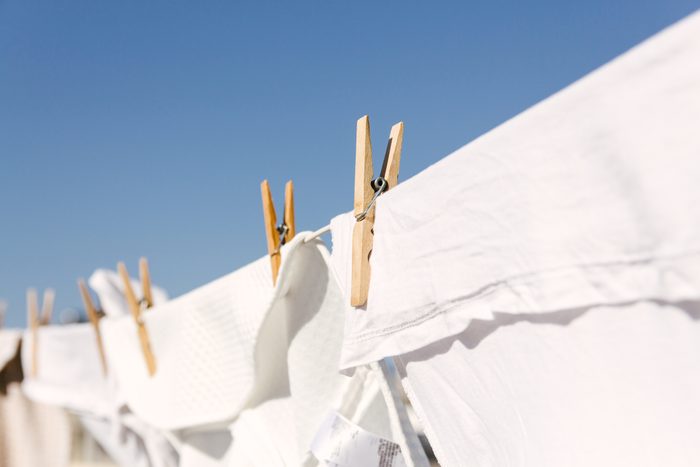How to Unshrink Clothes (and Prevent Them from Doing So in the First Place)

All hope isn't lost if you find your favorite clothing no longer fits after a trip through the dryer. Learn how to unshrink clothes from cotton to wool with our step-by-step guide.
It happens to the best of us. You (or your well-intended family member!) reaches into the laundry basket and unknowingly tosses your favorite sweater, pair of jeans, or dress in the dryer on high heat, and it comes out a few sizes too small, too short, or totally misshapen. At some point in your laundering life—even for those who know how to do laundry the right way—it is inevitable that you will accidentally shrink a piece of clothing that belongs to yourself or a loved one. Though there are times you may want to intentionally shrink your clothes.
However, before you donate the shrunken clothing item to your child’s doll, there might be a chance you can undo some of the damage. Even though you might not be able to totally unshrink your clothes, there are steps you can take to stretch or loosen the fabric.
Mary Gagliardi, aka “Dr. Laundry,” Clorox’s in-house scientist and cleaning expert, gives us the rundown on how to easily unshrink clothes.
Why do clothes shrink?
Provided you follow the instructions on the laundry care tag, a high-quality garment or fabric should have the ability to maintain its original shape and good dimensional stability, meaning you should be able to wash and dry it without its size being impacted. However, there are a variety of reasons why a product might shrink.
Fiber type is the main reason why a clothing item shrinks, according to Gagliardi. Natural fabrics, such as cotton and linen are more likely to shrink because of their moisture absorption properties, she explains. Natural animal hair fibers—think wool and cashmere—also absorb moisture, but they also “felt,” a permanent interlocking of fibers that make a clothing item appear smaller, once wet which can be mistaken for shrinking.
Other reasons why clothing might shrink has to do with how much tension a yarn is under when the fabric is woven or knitted or while it is being processed, and the overall quality of the clothing. In general, higher-quality manufacturers use special finishes and production techniques to prevent shrinkage.
How can you prevent shrinking in the first place?
With cotton items, lowering the wash temperature and air drying will help prevent a garment from shrinking. Blue jeans and other heavier sturdier fabrics can be hung by the hems on pants hangers to line dry. The weight of the damp fabric will naturally lengthen the legs as the jeans air dry. Less sturdy lightweight fabrics should lay flat to dry because wet fabric is heavier than dry fabric, and shoulder seams can rip out or stretch if hung to dry. Accidentally spill something? You can use this guide to remove any stain.
How can you unshrink clothes?
Once the damage is done, follow these steps to unshrink clothes.
1. Fill a sink or tub with lukewarm water and add a capful of baby shampoo, hair conditioner, or laundry soap formulated for delicate cycles. These are the best laundry detergents, FYI.
2. Soak for up to 30 minutes to loosen fibers.
3. Remove the item of clothing from the water and gently squeeze the water from the clothing, but do not rinse it out.
4. Lay the clothing on a flat towel and roll it up, gently squeezing it until the item is damp and not wet.
5. Lay the clothing item on another dry flat towel, gently stretching it back to preshrunk size.
6. Allow the item to air dry.
Other tips for unshrinking clothes
Gagliardi suggests a few other strategies when it comes to unshrinking special fabrics and clothing items.
Cotton sweaters
Worried about washing your cotton sweater even though the label says it’s OK? Trace an outline of it on paper before you wash it. This will help you tell if it did shrink and, in the event it does, you can use the guide to help you reshape it to its original dimensions following the steps above.
Wool knits
Wool knits that have not felted (which is permanent) can be gently stretched out by softly tugging the fabric while it is damp, Gagliardi says. However, she notes that you should always prevent felting from occurring in the first place by following care instructions. “If it says dry clean only, then that’s your only choice for fabric care. If handwashing is allowed, the sweater should be washed and rinsed in the same lukewarm water temperature,” she says. Additionally, agitation should be kept to an absolute minimum. “Instead of swishing or wringing the sweater, the cleaning solution should be gently squeezed through the fabric. Hot water, agitation, twisting, and wringing all contribute to felting, so must be avoided.” Here is how to hand-wash your clothes the right way.
Polyester and other synthetics
Polyester and other synthetics are not prone to shrinkage. In fact, some machine washable wools are actually blends that utilize a small percentage of polyester or acrylic to stabilize the wool and prevent shrinkage, Gagliardi says.







